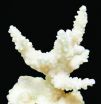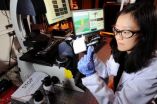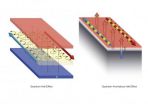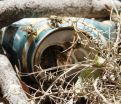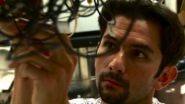(Press-News.org) PHILADELPHIA, Aug. 19, 2012 — In a discovery that defies the popular meaning of the word "wire," scientists have found that Mother Nature uses DNA as a wire to detect the constantly occurring genetic damage and mistakes that ― if left unrepaired ― can result in diseases like cancer and underpin the physical and mental decline of aging.
That topic ― DNA wires and their potential use in identifying people at risk for certain diseases ― is the focus of a plenary talk here today during the 244th National Meeting & Exposition of the American Chemical Society, the world's largest scientific society. The meeting, which features about 8,600 reports with an anticipated attendance of 14,000 scientists and others continues here through Thursday.
"DNA is a very fragile and special wire," said Jacqueline K. Barton, Ph.D., who delivered the talk. "You're never going to wire a house with it, and it isn't sturdy enough to use in popular electronic devices. But that fragile state is exactly what makes DNA so good as an electrical biosensor to identify DNA damage."
Barton won the U.S. National Medal of Science, the nation's highest honor for scientific achievement, for discovering that cells use the double strands of the DNA helix like a wire for signaling, which is critical to detecting and repairing genetic damage. She is a professor of chemistry and is chair of the division of chemistry and chemical engineering at the California Institute of Technology in Pasadena.
Damage is constantly occurring to DNA, Barton explained ― damage that skin cells, for instance, receive from excessive exposure to sunlight or that lung cells get hit with from carcinogens in cigarette smoke. Cells have a natural repair system in which special proteins constantly patrol the spiral-staircase architecture of DNA. They monitor the 3 billion units, or "base pairs," in DNA, looking for and mending damage from carcinogens and other sources.
Barton and other scientists noticed years ago that the DNA architecture chemically resembles the solid-state materials used in transistors and other electronic components. And DNA's bases, or units, are stacked on top of each other in an arrangement that seemed capable of conducting electricity.
"It's like a stack of copper pennies," said Barton. "And when in good condition and properly aligned, that stack of copper pennies can be conductive. But if one of the pennies is a little bit awry ― if it's not stacked so well ― then you're not going to be able to get good conductivity in it. But if those bases are mismatched or if there is any other damage to the DNA, as can happen with damage that leads to cancer, the wire is interrupted and electricity will not flow properly."
Barton's team established that the electrons that comprise a flow of electricity can move from one end of a DNA strand to the other, just as they do through an electrical wire. In one recent advance, the team was able to send electricity down a 34-nanometer-long piece of DNA. That might not sound like much — a nanometer is one-tenth the width of a human hair. But that is just the right scale for use in medical diagnostic devices and biosensors to pick up on mutations, or changes, in DNA that could lead to cancer and other diseases.
Barton's research suggested that DNA uses its electrical properties to signal repair proteins that fix DNA damage. If the DNA is no longer conducting electricity properly, that would be a signal for repair proteins to do their thing. Barton's team is applying that knowledge in developing "DNA chips," devices that take advantage of DNA's natural electrical conductivity and its ability to bind to other strands of DNA that have a complementary sequence of base units, and thus probe that sequence for damage. Such a DNA chip would help diagnose disease risk by changes in electrical conductivity resulting from mutations or some other damage.
Other plenary talks featured at the 244th National Meeting & Exposition of the American Chemical Society include:
Chad A. Mirkin, Ph.D., "Spherical nucleic acid (SNA) nanostructures: A new platform for intracellular gene regulation"
Buddy D. Ratner, Ph.D., "A 2012 perspective on biocompatibility: The contributions of the chemist"
John T. Santini, Ph.D., "Multireservoir drug therapies … from science to startups"
###Barton and colleagues acknowledge funding from the National Institutes of Health.
The American Chemical Society is a nonprofit organization chartered by the U.S. Congress. With more than 164,000 members, ACS is the world's largest scientific society and a global leader in providing access to chemistry-related research through its multiple databases, peer-reviewed journals and scientific conferences. Its main offices are in Washington, D.C., and Columbus, Ohio.
To automatically receive news releases from the American Chemical Society, contact newsroom@acs.org.
Note to journalists: Please report that this research was presented at a meeting of the American Chemical Society.
Abstract
DNA charge transport chemistry offers an opportunity to carry out redox chemistry at a distance and thus provides a powerful platform for signaling, whether in the design of new sensors or in activating responses across the genome. Many experiments have now shown that DNA-mediated charge transport can arise over long molecular distances but in a reaction that is exquisitely sensitive to perturbations in the DNA base stack. Studies are described to illustrate this chemistry, to design new DNA-based sensors, and to characterize how DNA-binding proteins utilize DNA charge transport for long range signaling.
'DNA wires' could help physicians diagnose disease
2012-08-20
ELSE PRESS RELEASES FROM THIS DATE:
Meddling with male malaria mosquito 'mating plug' to control an epidemic
2012-08-20
PHILADELPHIA, Aug. 19, 2012 — Using information about the unique mating practices of the male malaria mosquito ― which, unlike any other insect, inserts a plug to seal its sperm inside the female ― scientists are zeroing in on a birth-control drug for Anopheles mosquitoes, deadly carriers of the disease that threatens 3 billion people, has infected more than 215 million and kills 655,000 annually.
They reported today at the 244th National Meeting & Exposition of the American Chemical Society on development of an approach for screening substances that could ...
Inspired by genetics, chemistry finally takes hold of its own code
2012-08-20
Stefan Matile opts for sincerity. For him, if organic chemistry is often fond of simplifying its functional systems, it is because it is mostly impossible for it to construct and manage molecular architectures as complex as those produced with tremendous efficiency in nature. "It's a fact", says the UNIGE professor and NCCR Chemical Biology member, "that we are far from being able to match the genius of nature."
Where the complexity arises
The specialist attributes the genetic code to this genius of nature. "It is rather simple because it is based on four foundations—adenine, ...
Improving water quality can help save coral reefs
2012-08-20
Research from the University of Southampton and the National Oceanography Centre, Southampton has found that an imbalance of nutrients in reef waters can increase the bleaching susceptibility of reef corals.
Corals are made up of many polyps that jointly form a layer of living tissue covering the calcareous skeletons. They depend on single-celled algae called zooxanthellae, which live within the coral polyps.
The coral animal and the associated zooxanthellae depend on each other for survival in a symbiotic relationship, where the coral supplies the algae with nutrients ...
Artificial intelligence helps detect subtle differences in mutant worms
2012-08-20
Research into the genetic factors behind certain disease mechanisms, illness progression and response to new drugs is frequently carried out using tiny multi-cellular animals such as nematodes, fruit flies or zebra fish.
Often, progress relies on the microscopic visual examination of many individual animals to detect mutants worthy of further study.
Now, scientists have demonstrated an automated system that uses artificial intelligence and cutting-edge image processing to rapidly examine large numbers of individual Caenorhabditis elegans, a species of nematode widely ...
A new route to dissipationless electronics
2012-08-20
A team of researchers at RIKEN and the University of Tokyo has demonstrated a new material that promises to eliminate loss in electrical power transmission. The surprise is that their methodology for solving this classic energy problem is based upon the first realization of a highly exotic type of magnetic semiconductor first theorized less than a decade ago - a magnetic topological insulator.
Development of energy saving technologies is one of the central pursuits of modern science. From advancing alternative energy resources like wind and solar power to improving the ...
The wasp that never cries wolf
2012-08-20
European paper wasps (Polistes dominula) advertise the size of their poison glands to potential predators, finds a new study published in BioMed Central's open access journal Frontiers in Zoology. The brighter the colour, the larger the poison gland.
Aposematism is used by many different animals to warn potential predators that they are poisonous. Usually this takes the form of distinctive colouration or patterns which predators quickly learn to avoid. Paper wasps have conspicuous yellow and black patterns covering their bodies and researchers from University of Granada ...
Massachusetts butterflies move north as climate warms
2012-08-20
PETERSHAM, Mass. (August 19, 2012)---The authors of a Harvard study published today in Nature Climate Change gathered their data from an unlikely source—the trip accounts of the Massachusetts Butterfly Club. Over the past 19 years, the amateur naturalist group has logged species counts on nearly 20,000 expeditions throughout Massachusetts. Their records fill a crucial gap in the scientific record.
Once analyzed, the data show a clear trend. According to Greg Breed, lead author on the study and a post-doctoral fellow at the Harvard Forest in Petersham, Mass., "Over the ...
UCSB researchers demonstrate that 15=3x5 about half of the time
2012-08-20
(Santa Barbara, Calif.) — Computing prime factors may sound like an elementary math problem, but try it with a large number, say one that contains more than 600 digits, and the task becomes enormously challenging and impossibly time-consuming. Now, a group of researchers at UC Santa Barbara has designed and fabricated a quantum processor capable of factoring a composite number — in this case the number 15 — into its constituent prime factors, 3 and 5.
Although modest compared to a 600-digit number, the achievement represents a milestone on the road map to building a ...
Researchers assess stereotypes of immigrants and views on the impact of immigration
2012-08-20
DENVER — A new study led by the University of Cincinnati examines stereotypes of immigrants from four global regions and measures opinions of the impact of immigration on U.S. society. The researchers say their findings provide the most solid evidence yet that perceptions of the characteristics of Latin American immigrants in particular are strongly linked to beliefs about the impact of immigration, especially on unemployment, schools, and crime. The research will be presented at the 107th Annual Meeting of the American Sociological Association.
The study was conducted ...
Binge drinking college students are happier than their non-binge drinking peers
2012-08-20
DENVER — Why do some colleges have persistently high levels of binge drinking? It may be because, at these schools, binge drinking is associated with high status and binge drinkers are happier with their college social experience than their non-binge drinking peers, suggests new research to be presented at the 107th Annual Meeting of the American Sociological Association.
"Binge drinking is a symbolic proxy for high status in college," said Carolyn L. Hsu, co-author of the study and an associate professor of sociology at Colgate University. "It's what the most powerful, ...
